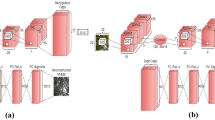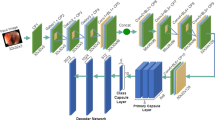Abstract
The retina is one of the most developed sensing organs in the human body. However, the knowledge on the coding and decoding of the retinal neurons are still rather limited. Compared with coding (i.e., transforming visual scenes to retinal spike trains), the decoding (i.e., reconstructing visual scenes from spike trains, especially those of complex stimuli) is more complex and receives less attention. In this paper, we focus on the accurate reconstruction of visual scenes from their spike trains by designing a retinal spike train decoder based on the combination of the Fully Connected Network (FCN), Capsule Network (CapsNet) and Convolutional Neural Network (CNN), and a loss function incorporating the structural similarity index measure (SSIM) and L1 loss. CapsNet is used to extract the features from the spike trains, that are fused with the original spike trains and used as the inputs to FCN and CNN to facilitate the scene reconstruction. The feasibility and superiority of our model are evaluated on five datasets (i.e., MNIST, Fashion-MNIST, Cifar-10, Celeba-HQ and COCO). The model is evaluated quantitatively with four image evaluation indices, i.e., SSIM, MSE, PSNR and Intra-SSIM. The results show that the model provides a new means for decoding visual scene stimuli from retinal spike trains, and promotes the development of brain-machine interfaces.




Similar content being viewed by others
References
Schwemmer MA, Skomrock ND, Sederberg PB, Ting JE, Sharma G, Bockbrader MA, Friedenberg DA (2018) Meeting brain-computer interface user performance expectations using a deep neural network decoding framework. Nat Med 24(11):1669–76. https://doi.org/10.1038/s41591-018-0171-y
Hutmacher F (2019) Why is there so much more research on vision than on any other sensory modality? Frontiers in psychology. https://doi.org/10.3389/fpsyg.2019.02246
Epstein Russell A, Baker Chris I (2019) Scene perception in the human brain. Annu Rev Vis Sci 5:373–97. https://doi.org/10.1146/annurev-vision-091718-014809
Langer Kirstin B, Ohlemacher SK, Phillips MJ, Fligor CM, Jiang P, Gamm DM, Meyer JS (2018) Retinal ganglion cell diversity and subtype specification from human pluripotent stem cells. Stem Cell Rep 10(4):1282–1293. https://doi.org/10.1016/j.stemcr.2018.02.010
Zhang Y, Jia S, Zheng Y, Yu Z, Tian Y, Ma S, Huang T, Liu JK (2020) Reconstruction of natural visual scenes from neural spikes with deep neural networks. Neural Netw 125:19–30. https://doi.org/10.1016/j.neunet.2020.01.033
Grimes WN, Songco-Aguas A, Rieke F (2018) Parallel processing of rod and cone signals: retinal function and human perception. Annual Rev Vis Sci 4:123–41. https://doi.org/10.1146/annurev-vision-091517-034055
O’Brien J, Bloomfield SA (2018) Plasticity of retinal gap junctions: roles in synaptic physiology and disease. Annual review of vision science 4:79–100. https://doi.org/10.1146/annurev-vision-091517-034133
Rivlin-Etzion M, Grimes WN, Rieke F (2018) Flexible neural hardware supports dynamic computations in retina. Trends Neurosci 41(4):224–37. https://doi.org/10.1016/j.tins.2018.01.009
Demb JB, Singer JH (2015) Functional circuitry of the retina. Network:, Computation in Neural Systems 12(2):199. https://doi.org/10.1146/annurev-vision-082114-035334
Chichilnisky EJ (2001) A simple white noise analysis of neuronal light responses. Front Syst Neurosci 10:109
Pillow JW, Shlens J, Paninski L, Sher A, Litke AM, Chichilnisky EJ, Simoncelli EP (2008) Spatio-temporal correlations and visual signalling in a complete neuronal population. Nature 454(7207):995–9. https://doi.org/10.1038/nature07140
Cessac B, Kornprobst P, Kraria S, Nasser H, Pamplona D, Portelli G, Viéville T (2017) PRANAS: A new platform for retinal analysis and simulation. Front Neuroinform 11:49. https://doi.org/10.3389/fninf.2017.00049
Meyer AF, Williamson RS, Linden JF, Sahani M (2017) Models of neuronal stimulus-response functions: elaboration, estimation, and evaluation. Front Systems Neurosci 10:109. https://doi.org/10.3389/fnsys.2016.00109
Botella-Soler V, Deny S, Martius G, Marre O, Tkačik G (2018) Nonlinear decoding of a complex movie from the mammalian retina. PLoS Comput Biol 14(5):e1006057. https://doi.org/10.1371/journal.pcbi.1006057
Pillow JW, Paninski L, Uzzell VJ, Simoncelli EP, Chichilnisky EJ (2005) Prediction and decoding of retinal ganglion cell responses with a probabilistic spiking model. J Neurosci 25(47):11003–13. https://doi.org/10.1523/JNEUROSCI.3305-05.2005
Parthasarathy N, Batty E, Falcon W, Rutten T, Rajpal M, Chichilnisky EJ, Paninski L (2017) Neural networks for efficient bayesian decoding of natural images from retinal neurons. Adv Neural Inf Process Syst 30:6434–45. https://doi.org/10.1101/153759
Sabour S, Frosst N, Hinton GE (2017) Dynamic routing between capsules. Adv Neural Inf Process Syst, pp 3859–3869
Roy K, Roy P, Chaudhuri SS (2021) Capsule Neural Network Architecture Based Multi-class Fruit Image Classification. In: Advances in smart communication technology and information processing:, OPTRONIX, vol 2020, pp 171–180
Wang Z, Simoncelli EP, Bovik AC (2003) Multiscale structural similarity for image quality assessment. In: The thrity-Seventh asilomar conference on signals, systems and computers, vol 2003, pp 1398–1402
Pathak D, Krahenbuhl P, Donahue J, Darrell T, Efros AA (2016) Context encoders: Feature learning by inpainting. Inproceedings of the IEEE conference on computer vision and pattern recognition, pp 2536–2544
Isola P, Zhu JY, Zhou T, Efros AA (2017) Image-to-image translation with conditional adversarial networks. Inproceedings of the IEEE conference on computer vision and pattern recognition, pp 1125–1134
Gadirov H (2018) Capsule architecture as a discriminator in generative adversarial networks. MS thesis
Li W, Raj AN, Tjahjadi T, Zhuang Z (2021) Digital hair removal by deep learning for skin lesion segmentation. Pattern Recogn 117:107994. https://doi.org/10.1016/j.patcog.2021.107994
Onken A, Liu JK, Karunasekara PC, Delis I, Gollisch T, Panzeri S (2016) Using matrix and tensor factorizations for the single-trial analysis of population spike trains. PLoS comput biol 12(11):e1005189. https://doi.org/10.1371/journal.pcbi.1005189
Brackbill N, Rhoades C, Kling A, Shah NP, Sher A (2020) Reconstruction of natural images from responses of primate retinal ganglion cells. Elife 9:e58516. https://doi.org/10.7554/eLife.58516
Kim YJ, Brackbill N, Batty E, Lee J, Mitelut C, Tong W, Chichilnisky EJ, Paninski L (2021) Nonlinear decoding of natural images from large-scale primate retinal ganglion recordings. Neural Comput 33(7):1719–50. https://doi.org/10.1162/neco_a_01395
Odermatt B, Nikolaev A, Lagnado L (2012) Encoding of luminance and contrast by linear and nonlinear synapses in the retina. Neuron 73(4):758–73. https://doi.org/10.1016/j.neuron.2011.12.023
Benoit A, Caplier A, Durette B, Hérault J (2010) Using human visual system modeling for bio-inspired low level image processing. Comput Vis Image Underst 114(7):758–73. https://doi.org/10.1016/j.cviu.2010.01.011
Martinez-Alvarez A, Olmedo-Payá A, Cuenca-Asensi S, Ferrández JM, Fernandez E (2013) Retinastudio: A bioinspired framework to encode visual information. Neurocomputing 114:45–53. https://doi.org/10.1016/j.neucom.2012.07.035
Nasser H, Kraria S, Cessac B (2013) Enas: a new software for neural population analysis in large scale spiking networks. BMC Neurosci 14(1):1–2. https://doi.org/10.1186/1471-2202-14-S1-P57
Cofre R, Cessac B (2014) Exact computation of the maximum-entropy potential of spiking neural-network models. Physical Review E 89(5):052117. https://doi.org/10.1103/PhysRevE.89.052117
Gollisch T, Meister M (2010) Eye smarter than scientists believed: neural computations in circuits of the retina. Neuron 65(2):150–64. https://doi.org/10.1016/j.neuron.2009.12.009
Wohrer A, Kornprobst P (2009) Virtual retina: a biological retina model and simulator, with contrast gain control. J Comput Neurosci 26(2):219–249. https://doi.org/10.1007/s10827-008-0108-4
Acknowledgements
This research was financially supported by the Scientific Research Grant of Shantou University, China, Grant (No. NTF17016), National Natural Science Foundation of China (No. 82071992) and Basic and Applied Basic Research Foundation of Guangdong Province [No. 2020B1515120061].
Author information
Authors and Affiliations
Corresponding author
Ethics declarations
Conflict of Interests
The authors declare that they have no conflict of interest.
Additional information
Publisher’s note
Springer Nature remains neutral with regard to jurisdictional claims in published maps and institutional affiliations.
Rights and permissions
About this article
Cite this article
Li, W., Joseph Raj, A.N., Tjahjadi, T. et al. Fusion of ANNs as decoder of retinal spike trains for scene reconstruction. Appl Intell 52, 15164–15176 (2022). https://doi.org/10.1007/s10489-022-03402-w
Accepted:
Published:
Issue Date:
DOI: https://doi.org/10.1007/s10489-022-03402-w




